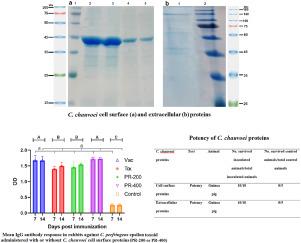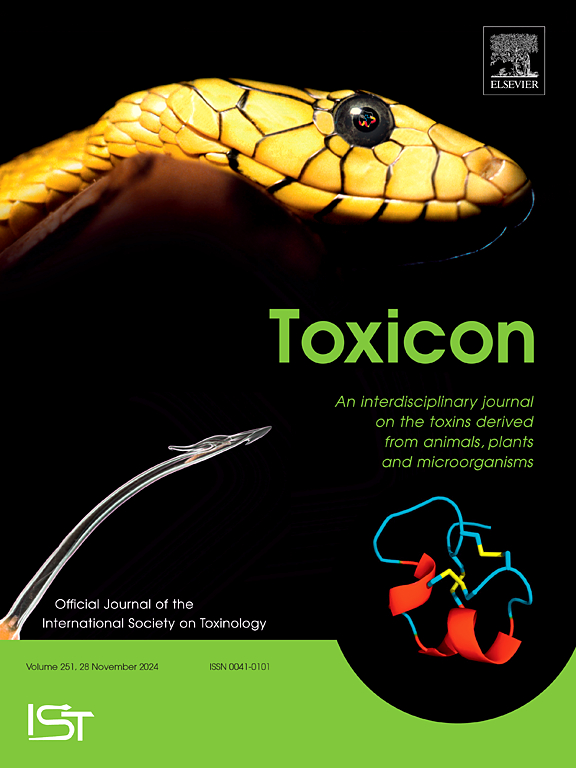梭状芽孢杆菌蛋白作为黑腿亚基疫苗或产气荚膜梭状芽孢杆菌epsilon类毒素佐剂的保护效力和免疫原性。
IF 2.6
4区 医学
Q2 PHARMACOLOGY & PHARMACY
引用次数: 0
摘要
研究了梭状芽孢杆菌蛋白作为黑脚亚基疫苗或产气荚膜梭菌epsilon类毒素疫苗生物佐剂的潜在应用。从 C. chauvoei 培养物中提取了胞外蛋白和细胞表面蛋白,并通过豚鼠效力试验评估了其保护效力。为了研究细胞表面蛋白对C:D 型产气包虫病类毒素上清液 + 200 μg C. chauvoei 细胞表面蛋白(PR-200)、类毒素上清液 + 400 μg 细胞表面蛋白(PR-400)、D 型产气包虫病灭活疫苗(Vac)、类毒素上清液(Tox)或 PBS。分离细胞表面蛋白可得到约 2.5 mg/L 的培养蛋白,其中 43 kDa 的尖锐条带可能与鞭毛蛋白相对应。效价测试表明,C. chauvoei 的细胞和细胞外蛋白都具有保护能力。酶联免疫吸附试验表明,PR-400和Vac组对epsilon类毒素的抗体滴度最高。免疫后天数对抗体反应的影响不显著。PR-400组和Vac组以及PR-200组和Tox组之间没有明显差异。Chauvoei 梭状芽孢杆菌细胞表面蛋白有可能用作黑腿病疫苗和梭状芽孢杆菌毒素的佐剂。本文章由计算机程序翻译,如有差异,请以英文原文为准。

Protection efficacy and immunogenicity of Clostridium chauvoei proteins as a subunit blackleg vaccine or an adjuvant for Clostridium perfringens epsilon toxoid
Potential application of Clostridium chauvoei proteins was studied as a subunit blackleg vaccine or a biological adjuvant for Clostridium perfringens epsilon toxoid vaccine. Extracellular and cell surface proteins were extracted from C. chauvoei culture, and their protective efficacy was evaluated by potency test in guinea pigs. In order to investigate the effect of cell surface proteins on C. perfringens epsilon toxoid immunogenicity, rabbits were inoculated subcutaneously twice with: C. perfringens type D toxoid supernatant +200 μg C. chauvoei cell surface proteins (PR-200), toxoid supernatant + 400 μg cell surface proteins (PR-400), inactivated C. perfringens type D vaccine (Vac), toxoid supernatant (Tox), or PBS. Isolation of cell surface proteins yielded about 2.5 mg/L culture protein with a sharp band at 43 kDa probably corresponding to flagellin. Potency test demonstrated the protection ability of both cellular and extracellular proteins of C. chauvoei. ELISA showed that the highest antibody titers against epsilon toxoid belonged to PR-400 and Vac groups. The effect of days post immunization on antibody response was not significant. No significant difference was observed between PR-400 and Vac, as well as PR-200 and Tox groups. Clostridium chauvoei cell surface proteins may have the potential for application as a blackleg disease vaccine and an adjuvant for clostridial toxoids.
求助全文
通过发布文献求助,成功后即可免费获取论文全文。
去求助
来源期刊

Toxicon
医学-毒理学
CiteScore
4.80
自引率
10.70%
发文量
358
审稿时长
68 days
期刊介绍:
Toxicon has an open access mirror Toxicon: X, sharing the same aims and scope, editorial team, submission system and rigorous peer review. An introductory offer Toxicon: X - full waiver of the Open Access fee.
Toxicon''s "aims and scope" are to publish:
-articles containing the results of original research on problems related to toxins derived from animals, plants and microorganisms
-papers on novel findings related to the chemical, pharmacological, toxicological, and immunological properties of natural toxins
-molecular biological studies of toxins and other genes from poisonous and venomous organisms that advance understanding of the role or function of toxins
-clinical observations on poisoning and envenoming where a new therapeutic principle has been proposed or a decidedly superior clinical result has been obtained.
-material on the use of toxins as tools in studying biological processes and material on subjects related to venom and antivenom problems.
-articles on the translational application of toxins, for example as drugs and insecticides
-epidemiological studies on envenoming or poisoning, so long as they highlight a previously unrecognised medical problem or provide insight into the prevention or medical treatment of envenoming or poisoning. Retrospective surveys of hospital records, especially those lacking species identification, will not be considered for publication. Properly designed prospective community-based surveys are strongly encouraged.
-articles describing well-known activities of venoms, such as antibacterial, anticancer, and analgesic activities of arachnid venoms, without any attempt to define the mechanism of action or purify the active component, will not be considered for publication in Toxicon.
-review articles on problems related to toxinology.
To encourage the exchange of ideas, sections of the journal may be devoted to Short Communications, Letters to the Editor and activities of the affiliated societies.
 求助内容:
求助内容: 应助结果提醒方式:
应助结果提醒方式:


